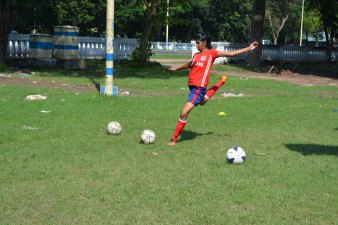When winds come, voices release the call,
Oceans sink and break the burning wall,
A crack lets in a thousand cries,
Together we march on upon the grave of our trial!!
(Image Courtesy: Swapan Kumar Paul)
What’s been written and spoken of Indian women’s football is rare. What’s tragic is, it is not an unexplored world where seeds need to be grown; it’s a neglected and ignored world where even the golden crops are blown away by the ruthless storm of corruption. But this has not stopped Indian women from playing football. Players, academicians, social activists and people from various spheres are coming together to promote Indian women’s football. The internet here has a limited reach. Dr. Subhransu Roy is one of those eminent scholars working extensively on Indian women’s football. From promoting the development to pointing out the loopholes, Dr. Roy has been dealing with this discipline since decades. I feel privileged to get in touch with him. In an hour-long interview, Dr. Roy spoke of some crucial, pertinent issues very few of us are aware of. Now let’s proceed to the interview:
Qs.1> Why have you chosen Indian women’s football as a serious academic discourse?
Ans.> The trend to work on sports history began in the early 1990s. In 1988, Soumen Mitra was the first to work on the history of Kolkata football in his M.Phil thesis. Works of Ramchandra Guha ( Corner of a Foreign Field: The Indian History of a British Sports), Mario Rodrigues ( Batting for the Empire: A Political Biography of Ranjitsinhji), Boria Majumdar ( 22 Yards to Freedom ), Kaushik Bandyopadhyay ( Scoring off the Field : Football Culture in Bengal 1911-1980) and others opened up a new sphere of research in sports history. A good number of popular writings with academic value and research potential especially on cricket and football came out during that time. I was exposed to football since my early days of childhood. I started going to Maidan from the age of 8. It was with my father that I watched the last derby match between Mohun Bagan-East Bengal at Eden Gardens. It was during my days of post-graduation in J.U. I was living at Garfa and came across a girl called Sujata Kar. She played 7 a-side and 8 a- side football with men, dribbling past them scoring goals. She was almost like a black sheep. The world had not watched Bend it like Beckham yet. In the year 2000, I came across a news-report which was the starting point for me. Two Kolkata girls, Alpana Shil and Sujata Kar got a chance in Bundesliga, one of the biggest leagues in the world. They played the exhibition match but could not make a professional contract because of AIFF’s failure to issue a clearance certificate. The reasons were the absence of an official club tournament for girls in India and the girls were not registered at any club. I was almost shocked. Though I was involved with football since the last two decades, I had no idea about women’s football. It was only in 1990s that I first witnessed an exhibition match of women’s football at Bhadreswar. Following the news, I went on to interview Sujata Kar who considered me a journalist. She was never interviewed in her life before. Then I got introduced to Shanti Mallick and Kuntala Ghosh Dastidar. When it comes to sports and gender, identity is very important. What I realized from those encounters was that Indian women are deprived of this identity. My journey as an academician in Indian women’s football started from that time.
Qs.2> While talking about women’s football, do you think Indian women’s football is structurally patriarchal?
Ans.> Football, not just women’s football is structurally patriarchal. The administrative structure of sports like kabbaddi or kushti or even athletics is patriarchal. We can’t deny that. Even for reformations, we have to face this patriarchy. Why do we need to say ‘women’s football?’ Why can’t we say ‘female category in football’? Football in Bengal has adopted a racial supremacy too. I would give you an example. There was an exhibition match in a remote village of the Hooghly district in which 1 female player scored a goal with ‘Acrobatic Back Volley’. The spectators started demanding that it is not possible for any woman to score like this and that she must be a man. The crowd was so enraged that the scorer was asked to prove her gender identity in front of everyone on the field itself. The players had to leave the ground and 4 police personnel were killed. It was a major set-back for women’s football in Bengal. The whole episode denotes the patriarchal attitude of football even among the spectators. The period saw more minor incidents and violence. In a nut-shell, all these incidents prove football in Bengal is absolutely under a patriarchal framework. In the Indian context, except Manipur and a few other North-Eastern states, the scenario isn’t completely different.
Qs.3> Is the feminine attribute of women a threat to the masculine world of sports?
Ans.> Yes. 100% !! Sports like golf has incorporated women too but for football, it’s a big NO. FIFA recognized women’s football officially in 1989. When we talk about a woman in the football ground, either she is a ‘stare girl’ or a football fan. The space of accepting a woman as a football player has not been created even now. Indian women footballers were not allowed to play in Bangladesh when they went there for a match in 2004. Unfortunately, apart from Iran, no feminist movement has taken up the issue of football. There has been a trend in USA and UK but it couldn’t spread widely. We need to see women as football players. Women should be given the rights to play football.
(Image Courtesy: Swapan Kumar Paul)
Qs.4> In the scenario where Manipur has made a tremendous advancement ignoring the political and socio-cultural oppression within the state, why do you think West Bengal is lagging behind?
Ans.> There are some specific reasons behind this:
- Attitude: The Maity/ Meity community of Manipur has a social balance. It is not too much patriarchal or too much matriarchal. This allows their women to play football.
- Religious practice: Participating in public sports is an act of practicing religion in Manipur. It is the religious belief there that if one takes part in sports, one will be pious. Hence, the girls can play football. They take part in the game regularly.
- Infrastructure: The infrastructure is well developed. Manipur has a huge number of leagues which are conducted on a regular basis. The number of women footballers getting registered as provisional players is also increasing day by day. The players have ample job opportunities; women footballers are hired to play in the office teams which give them the liberty to adopt football as a profession. 3 women from Manipur are playing in clubs abroad. West Bengal lacks these.
Qs.5> Do you think our consequent victories in the SAFF Championship will help in the development of Indian women’s football?
Ans.> Yes, definitely. There is no female wing in the football championship of Commonwealth Games. So SAFF is indeed a platform for our players to showcase their talent, to show the world that women’s football exists. Our women footballers lost in the first round of AFC but the good thing is that they are playing. Women should participate more in national and international tournaments to get the exposure.
Qs.6> In the scenario where I-League is coming to an end and ISL is taking over with corporate infiltrating the Indian football, what effects do you think this will have on the newly started Indian women’s football league which is the first of its kind?
Ans.> Nita Ambani has been there as the Chief Advisor of Indian women’s football for the last 6 years but has helped in zero development. In the first 3 years, National Championship Tournaments were not organized. Now it is an almost open secret that FIFA is providing huge money for the development of women’s football and it should be used in a proper manner. Honestly speaking, corporate will come but not for just the development of the game; rather exposure and financial benefits are their primary interests. When we have a ready infrastructure, then it will be good if the corporate comes. In the very recent past, AIFF at last introduced National Women’s Football League. We have to observe this recent development in Indian women’s football with a positive approach.
Qs.7> Do you think that football can be considered as a way of resistance against the knowledge system and the social system of patriarchy?
Ans.>Yes. Football is a highly effective form of resistance. Football is a team game where girls come from various socio-cultural milieu. Football helps in creating togetherness. Women share experiences among themselves, they share their day-to-day difficulties which give them the strength to defeat the patriarchy from its root, from their domestic space and help them move forward.
About Dr. Subhransu Roy:
Dr. Subhransu Roy is an academician working on the history of sports. He is also a regular contributor to various newspapers.
Acknowledgement:
- I would like to thank Dr. Subhransu Roy for taking time off his busy schedule and talk at length about his work.
- I am grateful to Dr. Nibabari Banerjee for getting me connected to Dr. Roy and guiding me with the questionnaire.
- I would also like to thank Swapan Kumar Paul for allowing me to take his photographs.



